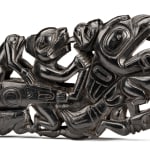-
Artworks
UNIDENTIFIED HAIDA MAKER
Early Haida-Motif Panel Pipe, c. 1830sargillite, with metal stand, 3.25 x 7.5 x 1 in (8.3 x 19.1 x 2.5 cm) (measurements reflect dimensions without stand)
unsigned.
LOT 54
ESTIMATE: $20,000 — $30,000
PRICE REALIZED: $21,600.00Further images
-
(View a larger image of thumbnail 1
)

-
(View a larger image of thumbnail 2
)

-
(View a larger image of thumbnail 3
)

-
(View a larger image of thumbnail 4
)

-
(View a larger image of thumbnail 5
)

-
(View a larger image of thumbnail 6
)

-
(View a larger image of thumbnail 7
)

-
(View a larger image of thumbnail 8
)

This densely composed and highly pierced, five-sided argillite pipe is especially impressive considering its small size. Nine or ten closely interwoven figures occupy the space, each one carved in classic...This densely composed and highly pierced, five-sided argillite pipe is especially impressive considering its small size. Nine or ten closely interwoven figures occupy the space, each one carved in classic Haida style with an unusual amount of character apparent in their appearances. Starting at the centre of the narrow side of the pipe, where the mouthpiece is in the top of a large thunderbird’s head, the figures (in clockwise order) are: A frog standing on the breast of the thunderbird, a bear whose body passes through the thunderbird’s wings, a human figure facing the bear whose human-like front feet are resting on the man’s shoulders, the tip of the man’s tongue caught in the bear’s mouth. Behind the human figure is the large head of what may be a sea lion, with the bowl of the pipe in the top of its head. The lower jaw of the sea lion is overlapped by the head and wings of a small eagle. Below the eagle is another bear, its feet and forepaws drawn up close to its body. The bear’s forepaws rest on the head of a human figure whose body and legs extend up toward the sea lion’s head. The man’s hands seem to be holding the hind flippers of the sea lion, and its body and legs extend along the bottom of the pipe to the feet of the next figure and bear number one. Beneath the head and body of the thunderbird that covers the mouthpiece is a humanoid bird image with wings and feet touching the feet of bear number one. This figure’s head has a human nose and mouth, suggesting a mythological entity that is not readily identifiable.
Steven C. Brown
Haida-motif panel pipes first appeared in the early 1830s, developing quickly from the smaller and less structurally complex ceremonial pipes. This exceptional pipe is both very early and brilliantly executed, one of the very finest examples we have seen from any period. Relatively thick in cross-section and with an interestingly shaped profile, the pipe’s imagery is complex and varied. Furthermore it is fully and expressively carved on every surface, and was obviously made to be held in the hand and admired from every conceivable angle. It is a masterpiece of the highest order.
References: For a similarly elaborate pipe collected possibly in 1825 but no later than 1839 in the collection of the Musée Quai Branly in Paris (formerly Musée de L’Homme) see Leslie Drew and Douglas Wilson, Argillite: Art of the Haida (Vancouver: Hancock House, 1980), p. 78. For another see Steven C. Brown, Native Visions: Evolution in Northwest Coast Art from the Eighteenth through the Twentieth Century (Seattle: Seattle Art Museum / Vancouver: Douglas & McIntyre, 1998), p. 96.Provenance
A European Private Collection;
Private Collection, Montreal.
-
(View a larger image of thumbnail 1
)
Join our mailing list
* denotes required fields
We will process the personal data you have supplied in accordance with our privacy policy (available on request). You can unsubscribe or change your preferences at any time by clicking the link in our emails.








